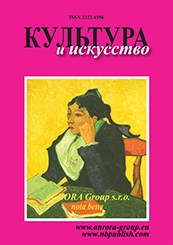Music and music culture
Reference:
Chzhuan, T., Michkov, P.A. (2023). Piano etudes by Lo Maisho: trends in the development of the genre. Culture and Art, 7, 1–11. https://doi.org/10.7256/2454-0625.2023.7.43467
Abstract:
In the modern professional piano art of China, the genre of piano etude is an important part of musical culture and occupies a special place in the history of Chinese music. The first samples of etudes for piano by Chinese composers date back to the 20s of the last century and were created as pieces for the development of the pianist's technical skills. During the development of the genre, the artistic value of the sketches has increased: from a play of a technical nature, the sketches have become independent, dramaturgically constructed compositions. The composers rely on the intonation features of national music, use the melodies of traditional Chinese songs, and resort to modern writing techniques. However, innovation is usually limited to this. The young Chinese composer Luo Maisho created a series of etudes in which, on the one hand, he inherits traditional methods of composition, on the other, he violates the established foundations. For the first time, the metrorhythm region becomes a donor for structural transformations. The author of the article introduces the work of the young composer, offers an excursion into the history of the development of the piano etude genre in China, provides an analysis of the metrorhythmic organization of Lo Maisho's etudes. Thus, the purpose of the study is to analyze new trends in the development of the piano etude genre in China, the subject is the metrorhythmic organization of the musical fabric. In piano studies, Lo Maisho reaches a new level in the progression of the genre. He identifies new trends in Chinese piano music, introducing elements of folk songs, imitation of the sounds of traditional musical instruments, reflecting the imagery and various cultural characteristics of the peoples of various regions of China, introduces new techniques of metrorhythmic organization. The composer does not limit himself to the use of pentatonics, but resolutely strives for innovations in the genre of etude. It is noteworthy that the author departs from the established tradition, which is based on the use of Western European techniques combined with the intonation culture of Chinese melodies, he offers new forms of compositional solutions.
Keywords:
etude in China, contemporary music, young composers, professional art of china, piano etude, Lo Maisho, Piano School of China, metrorhythm, metrortempo, cycle of etudes
Culture of art and the process of creation
Reference:
Rozin, V.M. (2023). The image of Russian life of the 90s through the veil of detective Alexandra Marinina "The Illusion of sin". Culture and Art, 7, 12–22. https://doi.org/10.7256/2454-0625.2023.7.43416
Abstract:
The subject of the study is, on the one hand, the artistic reality of Alexandra Marinina's novel "The Illusion of Sin", on the other hand, the analysis of the peculiarities of Russian life of the 90s, presented through the prism of this novel. The author doubts that this work can be fully summed up under the concept of the detective genre, since the background is a description and understanding of the life of Russia at that time. It is also unclear to him why Marinina's novel is so named, in connection with which it concerns four novels by Diana Soul, named in the same way. The comparison of Chekhov's "Cherry Orchard" and "The Illusion of Sin" allows us to formulate a hypothesis about the nature of Russian sociality. As before, two unrelated processes are impersonal, social (revolution, building socialism, war, the unexpected death of the USSR, reforms, etc., up to the present events) and unrelated and often meaningless, marginal actions and actions of people. From the point of view of this hypothesis, Marinina's work is considered: she, but naturally as an artist, represents for the reader the social reality of the 90s, which in many ways resembles the "bad sociality" that Vasily Zenkovsky wrote about back in the 20s of the last century. The author identifies four aspects of this sociality: the attitude of Russians to law stretching from the past centuries, the tradition of non-legal consciousness and behavior, a sense of social injustice, the lack of moral guidelines, the obsession of Russians with ideas, which M. Bakhtin wrote about.
Keywords:
life, detective, right, socialism, history, ideas, sociality, reality, morality, obsession
Theoretical culturology and the theory of culture
Reference:
Pankratova, A.V. (2023). Flat design as visualization of flat ontologies. Culture and Art, 7, 23–32. https://doi.org/10.7256/2454-0625.2023.7.43587
Abstract:
The object of this research is design as a semiotic embodiment of the modern worldview, the quintessence of which are flat ontologies. The subject of the study is parallelism in the philosophy of flat ontologies and modern flat design. The purpose of this study is to explicate the philosophical problem of modern design, which is a consequence of the unconscious expression by designers of the philosophy of flat ontologies. The philosophy of flat ontologies struggles with anthropocentrism, insisting that a person should not have a privileged ontological status compared to other objects. In the philosophy of flat ontologies, a machine or a neural network are agents of action in the same way as a person. Modern flat design is an expression of this position, since the modern visual information environment is less and less adapted to human organs of perception, more and more transhumanistic. Both flat design and flat ontologies are a consequence of the horizontally oriented, materialistic line of philosophy, which forms the worldview of modern society. Thanks to the explication of the problem of flat design, it can be understood that the horizontally oriented line of philosophy is problematic for the further existence of man. The main conclusion of the study is that the horizontally oriented line in philosophy – materialism and positivism – in their logical development lead to the philosophy of flat ontologies, which postulates the same ontological status for human and non-human agents. Such a position is antihuman and transhumanistic, and this becomes evident in the philosophical analysis of modern design. The main stylistics of modern design is a flat design, which uses fourth-order simulacra as the main type of signs. The use of simulacrum signs in design creates an environment that is increasingly less adapted to human organs of perception, a transhumanistic environment.
Keywords:
simulacrum, anthropocentrism, transhumanism, super-object, horizontal, flat ontologies, hyperreality, Flat design, environment, visual
Cultural heritage, tradition and innovation
Reference:
Zhukova, E.M. (2023). The Russian tradition of religious tolerance perception in the works of Russian thinkers of the XIX-XX centuries and modern realities. Culture and Art, 7, 33–56. https://doi.org/10.7256/2454-0625.2023.7.43513
Read the article
First Peer Review:
Second Peer Review:
Third Peer Review:
|
EDN: TGRYNM

|
Abstract:
The subject of the study is the ethical principle of religious tolerance. The aim was to study the Russian tradition of perception of the principle of religious tolerance and to build a theoretical model of religious tolerance, reflecting both historical experience and ideas. The work uses ethical, culturological and logical-methodological approaches. The first two allow us to consider religious tolerance as an ethical principle and as one of the important components of a person's spiritual life. The latter contributes to the disclosure of the principle of religious tolerance in its entirety. The scientific novelty consists in the fact that an ethical and cultural approach to the study of the principle of religious tolerance is proposed; the Russian tradition of perception of religious tolerance is revealed, a theoretical model of religious tolerance is built; a logical and methodological analysis of religious tolerance as an ethical principle is carried out, which allowed to reveal its structure and interrelated elements; the dynamics of the appeal of domestic authors to the topic of religious tolerance is demonstrated on the materials of the National Corpus of Russian language. The results of the study coincide with the scientific novelty. The relevance of the study is due to the possibility of its use in the development of the national idea of Russia. The practical significance lies in the possibility of applying the results in the field of education and socio-humanities, in legislative, as well as internal and foreign policy activities of Russia.
Keywords:
Russian philosophers, the essence of religious tolerance, the main elements of religious tolerance, religions, humanism, the model of religious tolerance, ethical and cultural approach, Corpus of the Russian language, Russian tradition, the principle of religious tolerance
Cultural heritage, tradition and innovation
Reference:
Rozin, V.M. (2023). Comments on S.G.Semenova's introductory article "Russian Cosmism" (changing the optics of comprehension). Culture and Art, 7, 57–69. https://doi.org/10.7256/2454-0625.2023.7.43621
Abstract:
The article discusses two main topics: Russian cosmism and the attitude towards it of Svetlana Semenova, who wrote the introductory article to the book "Russian Cosmism". Interesting considerations are given regarding the Russian cosmism of the philosopher A.P. Ogurtsov. The author problematizes the statements of Semenova, who distances herself from the views of cosmists and shares these views. He sees a similar ambivalent attitude in the polemic of I. Kant with the great scientist and esotericist of the XVIII century Emanuel Swedenborg. An analysis of the esoteric Christian teaching and the personality of the latter shows that Swedenborg simultaneously accepted two realities of spirit and nature, removing contradictions, bringing them into line with each other; at the same time, his psyche changed under the influence of work confirming the new picture of the world he had built. The author suggests that, like Swedenborg, cosmists and Semenova built a reality in which their dreams, intentions and actions received a place and meaning. He believes that in order to properly understand this type of creativity, a turn is needed to the problems and aspirations of the individual, to the built reality in which these problems are resolved (albeit in virtual terms for now), to the historical tradition of thinking. In his opinion, cosmists, Semenova and some modern ideologists like A. Dugin or Yu. Gromyko continue to move in line with the Russian tradition, outlined by Chaadaev, Dostoevsky and Russian religious philosophers. Another tradition characteristic of the creativity of these thinkers is esoteric, which allows you to create realities, omitting the problems of realization, following one ‒ constructing the world for your own personality.
Keywords:
spirit, nature, tradition, realization, mind, reality, esotericism, utopia, cosmism, conscience
Art and Art History
Reference:
Wu, G. (2023). The theme of the family in Soviet and Chinese woodcuts of the 1930s-1950s. Culture and Art, 7, 70–79. https://doi.org/10.7256/2454-0625.2023.7.43628
Abstract:
The article examines the features of the image of the family theme in the woodcuts of China and the USSR of the 1930s-1950s. The subject of the study are Soviet and Chinese woodcuts of the 1930s-1950s. The focus is on the analysis of the processes of interaction and mutual influence of graphic art of the two countries, special attention is paid to the study of expressive means and techniques used by artists to convey images of people within the family theme. The reasons for the appeal of the masters of engraving of the time under consideration to the theme of family, the embodiment of eternal universal values in the works, which became a common feature and trend of graphic art of the two countries in the middle of the twentieth century, are revealed. The scientific novelty lies in the introduction into scientific circulation and analysis of the works of woodcut of Russia and China, the identification of common and different features in the subject of Chinese woodcut and Soviet engravings of the 1930s-1950s. The study shows and substantiates the significant influence of Soviet realistic art on the work of Chinese masters, reveals the patterns of development of Chinese woodcut art in the period under review. In conclusion, the gradual appeal of Chinese artists to their own national heritage and the strengthening of the national identity of Chinese art in the middle of the twentieth century is noted, the causes of these processes in the artistic life of the country are revealed.
Keywords:
family, expressive means, plot, technic, national style, China, soviet realistic art, woodcut, engraving, mutual influence
Fine arts
Reference:
Bai, J. (2023). Reception of Soviet painting in the art of mainland China in the first half of the 20th century. Culture and Art, 7, 80–89. https://doi.org/10.7256/2454-0625.2023.7.43570
Abstract:
The realist ideas and revolutionary concepts characteristic of Russian oil painting were of special significance for the development of art in China in the 20th century. In particular, in the 1950s, the leaders of the Chinese Communist Party praised and promoted Russian and Soviet painting at the state level, which greatly contributed to the formation of the idea of realist painting and the scientific system of teaching oil painting in Chinese society. This paper examines the core values of socialism embodied in Russian oil painting and their derivatives; traces the development of oil painting in China; records the significant role of socialist features in the development of oil painting from different perspectives; and explains the influence of the Soviet art education system on the development of oil painting in China. This paper comprehensively examines the positive impact of Soviet painting on the development of Chinese art education, which contributed to the development of modern Chinese art in terms of artistic creativity, artistic organization and the construction of a system of art education.
Keywords:
art education, Chinese oil painting, art of socialist realism, socialist realism, Fine Arts, artistic development, Soviet oil painting, realistic oil painting, art development, art history
Music and music culture
Reference:
Liu, J. (2023). Russian and Chinese traditions in the piano piece by G. Ya. Ore “Fantasy of Southern China”. Culture and Art, 7, 90–98. https://doi.org/10.7256/2454-0625.2023.7.43647
Abstract:
The subject of the research is the piece for piano solo "Fantasy of Southern China: Lady and the Flower Seller" (1931) by the Russian émigré composer Harry Yakovlevich Ore (Xia Like, 1885-1972), forgotten in his homeland. A graduate of the St. Petersburg Conservatory, he lived most of his life in China, where he distinguished himself as a pianist, teacher and composer. Ore left a notable mark on the history of Chinese music, including as the author of the first piano arrangement of typical qupai melodies of the traditional Cantonese opera yueju. The purpose of the study is to consider Fantasia through the prism of the refraction of the Russian traditions of the St. Petersburg school (primarily The Russian Five) and the Chinese operatic traditions yueju. The article uses comparative typological and analytical research methods to substantiate the uniqueness of the selected piece as the first sample in the history of Chinese academic music that combines the melodies of Cantonese opera with the traditions of “New Russian school”. Piano piece “Fantasy of Southern China” by G. Ya. Ore is considered in Russian-language musicology for the first time. The main conclusions of the study are as follows. In the presented composition, the composer arranged four well-known tunes of the Cantonese yueju opera - "Ba Da Ban", "Toilet Table", "Product Sale" and " Narcissus flowers". The composer organically combined the national opera melodies of the Guangdong province in pentatonic modes with the writing techniques characteristic of the representatives of the St. Petersburg "New Russian School" (especially N. A. Rimsky-Korsakov, M. P. Mussorgsky) and its followers (A. K. Lyadov): variability, trichords, parallel-variable modes, plagal harmonies, smooth voice leading, melodization of voices, "singing" piano texture.
Keywords:
Chinese piano music, Russian emigration, Russian Five, Cantonese opera yueju, transcription, arrangement, Fantasies of Southern China, Xia Like, Garry Yakovlevich Ore, piano fantasy genre
 This work is licensed under a Creative Commons Attribution-NonCommercial 4.0 International License.
This work is licensed under a Creative Commons Attribution-NonCommercial 4.0 International License.
 Eng
Eng












 © 1998 – 2025 Nota Bene. Publishing Technologies. NB-Media Ltd.
© 1998 – 2025 Nota Bene. Publishing Technologies. NB-Media Ltd.




